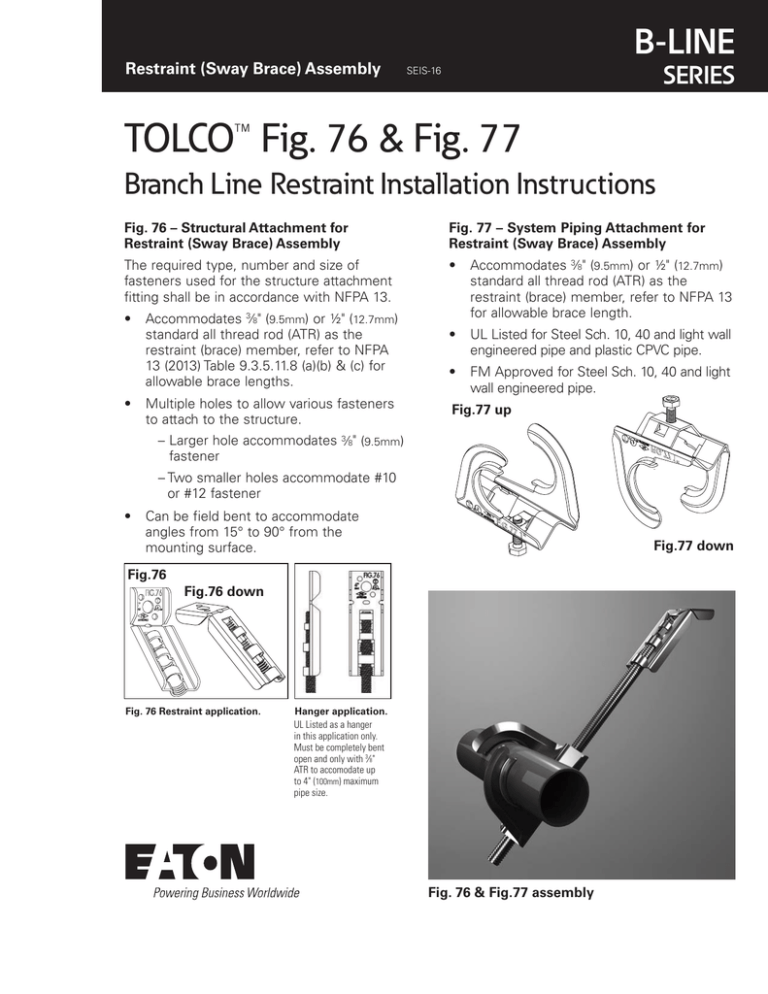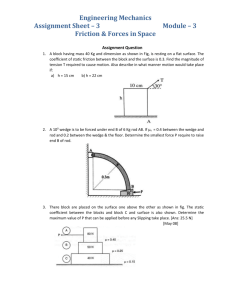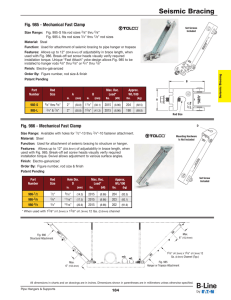
Restraint (Sway Brace) Assembly
B-LINE
SERIES
SEIS-16
TOLCO™ Fig. 76 & Fig. 77
Branch Line Restraint Installation Instructions
Fig. 76 – Structural Attachment for
Restraint (Sway Brace) Assembly
Fig. 77 – System Piping Attachment for
Restraint (Sway Brace) Assembly
The required type, number and size of
fasteners used for the structure attachment
fitting shall be in accordance with NFPA 13.
• Accommodates3⁄8" (9.5mm) or ½" (12.7mm)
standard all thread rod (ATR) as the
restraint (brace) member, refer to NFPA 13
for allowable brace length.
• Accommodates3⁄8" (9.5mm) or ½" (12.7mm)
standard all thread rod (ATR) as the
restraint (brace) member, refer to NFPA
13 (2013) Table 9.3.5.11.8 (a)(b) & (c) for
allowable brace lengths.
• Multipleholestoallowvariousfasteners
to attach to the structure.
• ULListedforSteelSch.10,40andlightwall
engineeredpipeandplasticCPVCpipe.
• FMApprovedforSteelSch.10,40andlight
wall engineered pipe.
Fig.77 up
– Larger hole accommodates 3⁄8" (9.5mm)
fastener
– Two smaller holes accommodate #10
or #12 fastener
• Canbefieldbenttoaccommodate
angles from 15° to 90° from the
mounting surface.
Fig.77 down
Fig.76
Fig.76 down
Fig. 76 Restraint application.
Hanger application.
UL Listed as a hanger
in this application only.
Must be completely bent
open and only with 3⁄8"
ATR to accomodate up
to 4" (100mm) maximum
pipe size.
Fig. 76 & Fig.77 assembly
Recommended Installation Method:
Step 1: Installallthreadrod(bracemember)toTOLCO™
Fig.76StructuralAttachment.BottomoutATRtoensure
fullthreadengagement.Thiscanbevisuallyconfirmed
due to the open thread design.
Step 2: InstallTOLCO™Fig.77SystemAttachment
tosprinklerpipebranchlinetoberestrained.Youcan
positionwiththerodengagementeitheraboveorbelow
thesprinklerpipe.Rodmustextendamin.of1"(25.4mm)
past the edge of the Fig. 77. The attachment can be slid
alongthepipetopositionclosetowheretheFig.76
structural attachment will be fastened to the structure. The
snapondesignallowsmaximumadjustabilityduringthis
stageoftheinstallationprocess.Canbefieldbentto
accommodate angles from 15° to 90° from the mounting
surface. The product shall not be bent more than three times
topreventmaterialfatigue.(SeeDetailA&Batright).
Step 3: EngageATR(previouslyattachedtothe
Fig.76StructuralAttachmenttotherodengagement
portionoftheFig.77SystemAttachment.DONOT
tighten the set bolt at this time.
Sway brace assemblies are intended to be installed
in accordance with NFPA 13 and the manufacturer’s
installation instructions.
Step 4: InstallFig.76StructuralAttachmenttothebuilding
structure. Follow fastener manufacturer and NFPA 13
guidelines to install appropriate fastener for the structural
type (i.e. concrete, wood, steel).
Step 5: TightensetboltonFig.77SystemAttachment
untilheadbreaksoffverifyingproperinstallationtorque.
All Thread Rod Maximum Restraint Lengths
Rod
Root
Least Radius
of Gyration
Maximum Unbraced Length (L) - in/Max.
Horizontal Load @ 45° (lbs.)**
Size (in)
Dia. (in)
r (in)
l/r=100
l/r=200
l/r=300
l/r=400†
3
⁄8
0.300
0.075
7/(300)
14/(186)
22/(82)
30/(44)
½
0.404
0.101
10/(300)‡
20/(300)‡
30/(152)
40/(85)
† l/r=400NFPA132010,Sec9.3.6.1(5)
†l/r=400NFPA132013,Sec9.3.6.1(5)
**Per NFPA 13 (2013)Table 9.3.5.11.8 (a)(b)(c); for additional load information at various other
angles see this table.
‡Max loadgovernedbyFig.76/77Maxhorizontalload.
15.00°
30.00°
45.00°
45.00°
UL Listed Maximum Allowable Loads (Horizontal)
Product
90.00°
Sch. 10, Sch. 40, Dynaflow & CPVC
/8" Rod
45.00°
½" Rod
3
(9.5mm)
(12.7mm)
Detail A
Detail B
Fig. 76
300 lbs.
300 lbs.
Fig. 77 – 1" (25.4)
300 lbs.
• Fig. 76 can be bent from the 45° angle
it is supplied with, up to a maximum
of 45° downward to allow an
installation with the rod perpendicular
to the mounting surface. (Detail A)
• Fig. 76 can be bent from the 45° angle
it is supplied with, up to a maximum
of 30° upward to allow an installation
with the rod at a 15° angle from the
mounting surface. (Detail B)
• The same bending angles apply to a
side mount application.
• A bend is defined as one direction within
the limits shown in details A & B above.
The Fig. 76 may be bent to accommodate
the desired angle within the specified
limits no more than three times. Excess
bending may cause material fatigue and
jeopardize the integrity of the part.
• These bending requirements apply to the
installation of the Fig. 76 as both as a
component of a branch line restraint or
component of a hanger assembly.
(1.344 kN)
(1.344 kN)
300 lbs.
(1.344 kN)
Fig. 77 – 1¼" (31.75)
300 lbs.
Fig. 77 – 1½" (38.1)
300 lbs.
Fig. 77 – 2" (50.8)
300 lbs.
(1.344 kN)
300 lbs.
(1.344 kN)
(1.344 kN)
300 lbs.
(1.344 kN)
(1.344 kN)
300 lbs.
(1.344 kN)
(1.344 kN)
FM Approved* Maximum Allowable Loads
Product
30° - 44°
/8" Rod ½" Rod
(9.5mm) (12.7mm)
3
45° - 59°
/8" Rod ½" Rod
(9.5mm) (12.7mm)
3
60° - 74°
/8" Rod ½" Rod
(9.5mm) (12.7mm)
3
Fig. 76
380
(1.69 kN)
420
(1.87 kN)
530
(2.36 kN)
580
(2.58 kN)
800
(3.56 kN)
1,020
(4.54 kN)
750
(3.34 kN)
1,110
(4.94 kN)
Fig. 77 – 1" (25.4)
140
(.623 kN)
160
(.712 kN)
200
(.890 kN)
230
(1.02 kN)
250
(1.11 kN)
280
(1.25 kN)
280
(1.25 kN)
320
(1.42 kN)
Fig. 77 – 1¼" (31.75)
140
(.623 kN)
170
(.756 kN)
200
(.890 kN)
250
(1.11 kN)
250
(1.11 kN)
300
(1.33 kN)
280
(1.33 kN)
340
(1.51 kN)
Fig. 77 – 1½" (38.1)
130
(.578 kN)
160
(.712 kN)
190
(.845 kN)
230
(1.02 kN)
230
(1.02 kN)
280
(1.25 kN)
260
(1.29 kN)
320
(1.42 kN)
Fig. 77 – 2" (50.8)
120
(.534 kN)
150
(.667 kN)
170
(.756 kN)
210
(.934 kN)
210
(.934 kN)
260
(1.29 kN)
240
(1.07 kN)
290
(1.29 kN)
3
75° - 90°
/8" Rod ½" Rod
(9.5mm) (12.7mm)
*Approved for Sch. 10, Sch. 40, Dynaflow, Eddy flow.
Marks shown are property of their respective owners.
Eaton
1000 Eaton Boulevard
Cleveland, OH 44122
United States
Eaton.com
© 2016 Eaton
All Rights Reserved
Printed in USA
Publication No. IL309002EN
January 2016 SEIS-16
B-Line Division
13201 Dahlia Street, Suite 200
Fontana, CA 92337
United States
Phone: 800-851-7415
www.cooperbline.com/tolco
Eaton is a registered trademark.
All other trademarks are property
of their respective owners.
Follow us on social media to get the
latest product and support information.





